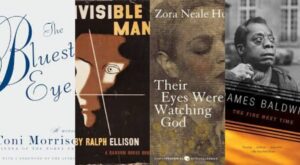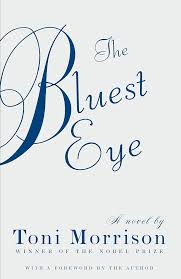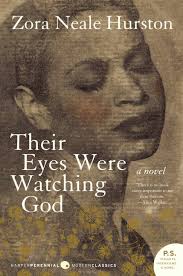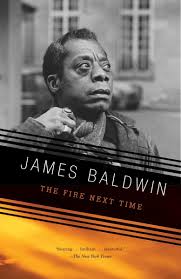
As we continue to celebrate Black History Month, I believe it is important to engage with Black art as much as possible. Our stories are so important and powerful. They can offer so much incite into the wide range of our culture. Below I will be listing some of my favorite reads by Black authors that I believe that people will benefit from reading this month and all of the time:
The Bluest Eye by Toni Morrison

“And fantasy it was, for we were not strong, only aggressive; we were not free, merely licensed; we were not compassionate, we were polite; not good, but well behaved. We courted death in order to call ourselves brave, and hid like thieves from life. We substituted good grammar for intellect; we switched habits to simulate maturity; we rearranged lies and called it truth, seeing in the new pattern of an old idea the Revelation and the Word.”
The Bluest Eye feels like one of the most important reads of my life. I did not read it until after high school and yet it resonated with me so much that it has become one of my favorite books. It is important not only for Black girls and women, but Black people in general to get a sense of what it is like to grow up in the world locked outside of so much that people seem to find beautiful and good. There is a Black nuclear family living in a very poor area navigating life. A good portion of the story is told through the lens of two little Black girls speaking on their perspectives, which is already meaningful given how much Black children are typically preferred to be seen rather than heard (and barely that). Getting to see how family secrets and life as an “undesirable” can take a toll on us, The Bluest Eye delves into the many layers of strife within the Black community from concepts of beauty, respectability, colorism, and how young girls can be “tainted” once they are violated. To think that all a little girl wished for would be to have blue eyes like the little white dolls everyone prefers is an indication of how lacking little Black girls are often made to feel. It’s a heavy, but necessary read that can help us not only look at ourselves, but also have some more empathy for those in our communities that are suffering in ways we can barely imagine. Her first novel and so incredibly essential.
Invisible Man by Ralph Ellison

“I am an invisible man. No, I am not a spook like those who haunted Edgar Allan Poe; nor am I one of your Hollywood-movie ectoplasms. I am a man of substance, of flesh and bone, fiber and liquids-and I might even be said to possess a mind. I am invisible, understand, simply because people refuse to see me.”
Invisible Man is another novel that was incredibly impactful to me from my first read. Over the years, I have found that as I evolve, as does my interpretation of the novel. It is not about true invisibility, but the particular invisibility that many Black people experience, particularly in the 1950s when this novel was originally published. Black people were not truly seen at all, we were far more likely to have other people’s projections put onto us based on their own prejudices. We witness a Black man, who remains unnamed with no description throughout the whole novel, primarily because he was forced to be a chameleon for his own survival. He had to change himself so many times over just to ensure that he did not put himself in a position to be a Black man in anyway that could put him in jeopardy. We all know that Black people have been killed many times over based on stereotypes and the imagination of white people proving to be more important than our lives. With Invisible Man we get to see the many different ways in which Black people have to fight in order to simply find place in America. Through this novel, we get a strong lesson in how our innate “invisibility”, which occurs due to how people choose to view us versus how we actually are, can either break us or offer us the opportunity to choose for ourselves who we are in circumstances that help maintain us. I can just imagine what it would have felt like to be a Black person in 1954, the same year that Brown vs the Board of Education came through the Supreme Court, and being able to read a novel that so perfectly described the tightrope experience that we have trying to survive under circumstances made terrible, as well as avoiding being killed for no good reason. It had to have been an incredible book to have during those times.
Their Eyes Were Watching God by Zora Neale Hurston

“They seemed to be staring at the dark, but their eyes were watching God.”
Zora Neale Hurston was as much a story collector as she was a storyteller. She often wrote down the folklore from African Americans, showing that it was not all just nonsense, but actual implications of our culture. Zora recognized the importance of the stories that were told by people who had largely been prevented from reading and writing. Their Eyes Were Watching God maintains elements of that storytelling and folklore, as it is written as a retelling by Janie, a light-skinned Black woman that had gone through a series of relationships that greatly impacted her life. From being raised by her grandmother, who was formerly enslaved, to being married off to a much older man, but then stealing off with an ambitious Black man who was determined to build a town for Black people. Through the treatment of the outside world, the men she was with, and the communities that she lived in, we get to see what it was like to be a high yellow Black woman forced to navigate the unpredictable world of African Americans in times when we were still just barely free. We get to see how the people we live our lives with impact our experiences and how true freedom is won through self-determination and true love. Janie goes from young girl given away as a wife and often defined by her husband, to being a Black woman who finds her way into a better life with a man who actually sees her and cares enough to allow her to experience life with him, as opposed to just being his helpmate. Not to mention how Zora set down our language, maintaining our ways of speech as another part of our culture. This novel is a time capsule in the best way.
The Fire Next Time by James Baldwin

“And there seemed to be no way whatever to removed this cloud that stood between them and the sun, between them and love and life and power, between them and whatever it was that they wanted. One did not have to be very bright to realize how little one could do to change one’s situation; one did not have to be abnormally sensitive to be worn down to a cutting edge by the incessant and gratuitous humiliation and danger one encountered ever working day, all day long.”
James Baldwin is well-known as one of the great Black writers and activists that we have been blessed to experience. Having been born in 1924 and going on to become an early protégé as a minister, Baldwin had a very unique perspective. Eventually moving away from the church, Baldwin saw racism and prejudice for what they were and was never afraid to speak truth to power. He showed the fire necessary for Black people constantly put in the terrible position of having to prove that we are worthy of being alive. From his elegance and the continued strength of voice that he first built in the church, Baldwin had the gift of being able to both captivate the heart and mind. As much sense as he had, he did not lose the feeling. The Fire Next Time is a powerful, yet short read that perfectly captures the fighting spirit of African Americans. The book speaks to how the “Negro problem” has impacted Black people in America and what is necessary to restore our dignity. Particularly during these times, it is important to tap into that spirit of determination and refusal to be broken.
——————
These are just the first batch of books I believe are important to read. Go to your local library, independent bookstore, or find eBooks either through your preferred online bookseller or through apps like Libby where you can access books for free. As our ancestors fought hard to be able to read, it is important that we honor their sacrifices by taking advantage of the privileges that many died for.
Leave a Reply